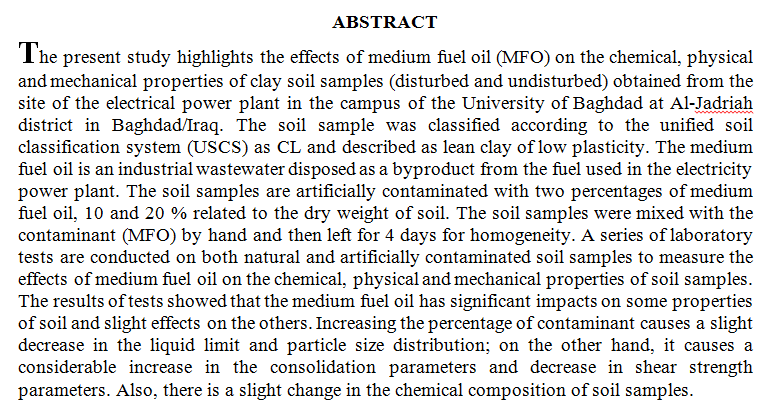
A progression of Polyaniline (PANI) and Titanium dioxide (TiO2) nanoparticles (NPs) were prepared by an in-situ polymerization strategy within the sight of TiO2 NPs. The subsequent nanocomposites were analyzed using Fourier-transform infrared spectra (FTIR), X-ray diffraction (XRD), Scanning Electron Microscopy (SEM), and Energy Dispersive X-Ray Analysis (EDX) taken for the prepared samples. PANI/TiO2 nanocomposites were prepared by various compound materials (with H2SO4 0.3 M and without it, to compare the outcome of it) by the compound oxidation technique using ammonium persulfate (APS) as oxidant within the sight of ultrafine grade powder of TiO2 cooled in an ice bath.
... Show More (1)
(1)
Thin films of In2O3-CdO at various CdO contents (0.01, 0.02, 0.03, 0.04 and 0.05) were deposited on transparent substrate which is glass using chemical spray pyrolysis deposition method at substrate temperature 150oC. The structural properties was studied to characterize the prepared materials by XRD analysis. Surface morphology has been illustrated using scanning electron microscopy which proved the nanosize of prepared materials. This materials have been used as gas sensor for toxic gas which is hydrogen sulfide H2S. The sensitivity and response speed have been investigated with addition of CdO nanoparticles. © 2021, S.C. Virtual Company of Phisics S.R.L. All rights reserved.
Suggested in this study the introduction of monomers have the ability to interact with polyester Rzn way confused or Alchapak Vodev polycarbonate first Almiaal acrylate ????? grains and offered models for high temperature and for a period of time of 40 days and absorbance and penetration and after color changes resulting from the storage heat higher using shades where models were extractedthermal storage and take measurements and then returned periodically results were consistent with theoretical expectations and mixing
In this work, zinc oxide nanoparticles (ZnONPs) and sawdust/epoxy composite (20:80) were mixed using a simple molding method with different ZnONPs concentrations of (0.1, 0.3, 0.5, 0.7, and 1.0 %). The samples of the nanocomposites were characterized by the Scanning Electron Microscopy (SEM) technique to demonstrate the homogeneity of the prepared ZnONPs/nanocomposites. The photocatalytic activity of the samples was examined using the methylene blue (MB) dye as a pollutant solution, through evaluation of the efficiency of the prepared compound in the treatment of organic pollutants under illumination by sunlight. The photocatalytic results showed that after 240 minutes of exposure to sunlight, the sample prepared using (0.5 vol.% of ZnON
... Show More (5)
(5)
Lead selenide PbSe thin films of different thicknesses (300, 500, and 700 nm) were deposited under vacuum using thermal evaporation method on glass substrates. X-ray diffraction measurements showed that increasing of thickness lead to well crystallize the prepared samples, such that the crystallite size increases while the dislocation density decreases with thickness increasing. A.C conductivity, dielectric constants, and loss tangent are studied as function to thickness, frequency (10kHz-10MHz) and temperatures (293K-493K). The conductivity measurements confirm confirmed that hopping is the mechanism responsible for the conduction process. Increasing of thickness decreases the thermal activation energy estimated from Arhinus equation is
... Show More (2)
(2)
The effect of Al dust particles on glow discharge regions, discharge
voltage, discharge current, plasma potential, floating potential,
electron density and electron temperature in planar magnetron
sputtering device has been studied experimentally. Four cylindrical
Langmuir probes were employed to measure plasma parameters at
different point on the radial axis of plasma column. The results
shows the present of Al dust causes to increase the discharge voltage
and reduce the discharge current. There are two electron groups in
the present and absent of Al dust particles. The radial profiles of
plasma parameters in the present of dust are non- uniform. The
floating potential of probe becomes more negatively while
Polymer blended electrolytes of various concentrations of undoped PAN/PMMA (80/20, 75/25, 70/30, 65/35 and 60/40 wt%) and doped with lithium salts (LiCl, Li2SO4H2O, LiNO3, Li2CO3) at 20% wt have been prepared by the solution casting method using dimethylformamide as a solvent. The electrical conductivity has been carried out using an LCR meter. The results showed that the highest ionic conductivity was 2.80x10-7 (Ω.cm)-1 and 1.05x10-1 (Ω.cm)-1 at 100 kHz frequency at room temperature for undoped (60% PAN + 40% PMMA) and (80% PAN + 20% PMMA) doped with 20%wt Li2CO3 composite blends, respect
... Show More (1)
(1)
Polyaniline (PANI) has been prepared by the oxidation method in order to fabricate it with various concentrations of copper nanoparticles (CuNPs) which produced using the reduction method. Various techniques have characterized pure PANI and PANI doped CuNPs composites, such as fourier transform infrared spectroscopy (FT-IR), X-ray diffraction spectroscopy (XRD), field emission scanning electron microscopy (FE-SEM) and energy dispersive X-ray spectroscopy (EDS), which were provided important information about the structure and morphology of the fabricated polymer nanocomposites. The properties of dielectric permittivity (έ), dielectric loss (ἔ) and electrical conductivity (σ_AC) properties were studied at room temperature versus a range
... Show More (1)
(1)
The nonlinear refractive index and the nonlinear absorption coefficient of unmodified and functional poly(methyl methacrylate) PMMA films were studied before and after the addition of the filler by the z-scan technique, using a Q-switched Nd:YAG laser at two wavelengths: 532 nm and 1064 nm, and at three input energies (13, 33 and 53) mJ. Both linear and nonlinear refractive indices and absorption coefficients of polymer films were studied by using UV-VIS spectrophotometer. The results show that the creation of functional PMMA from unmodified PMMA will increase the nonlinear optical properties in the functional PMMA/copper matrix more than in the unmodified PMMA/copper matrix. Hence, the functional PMMA appears promising as a useful third
... Show More